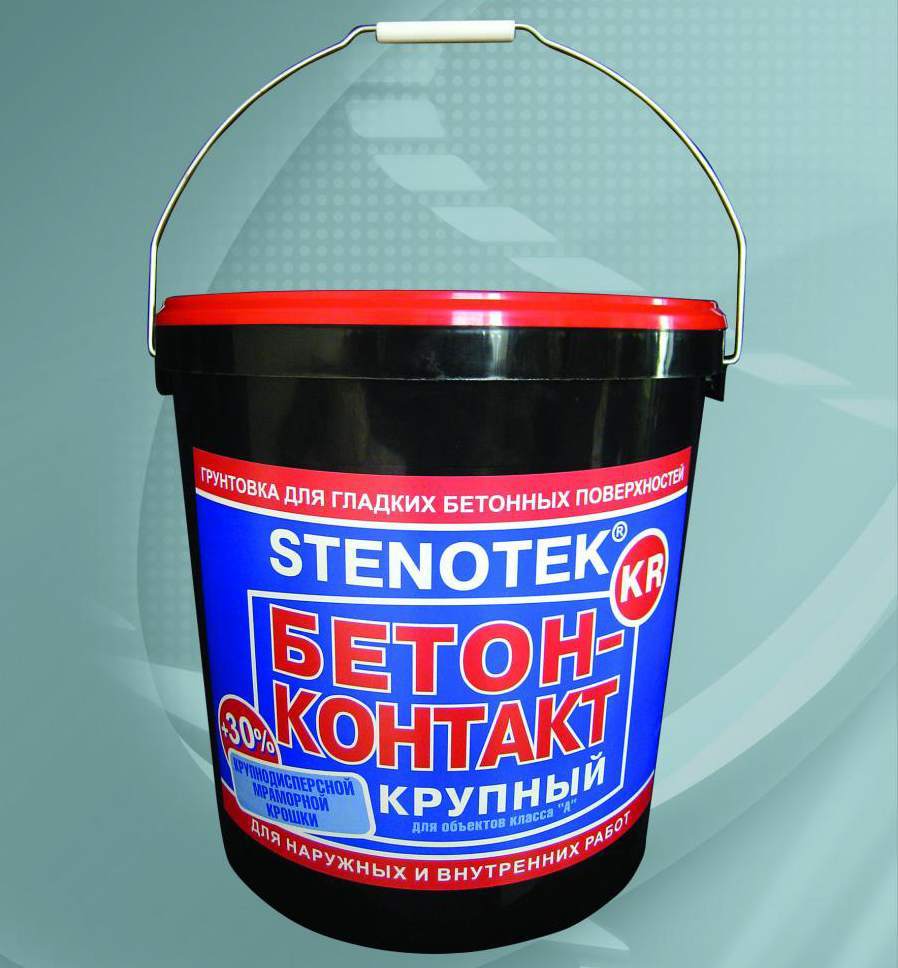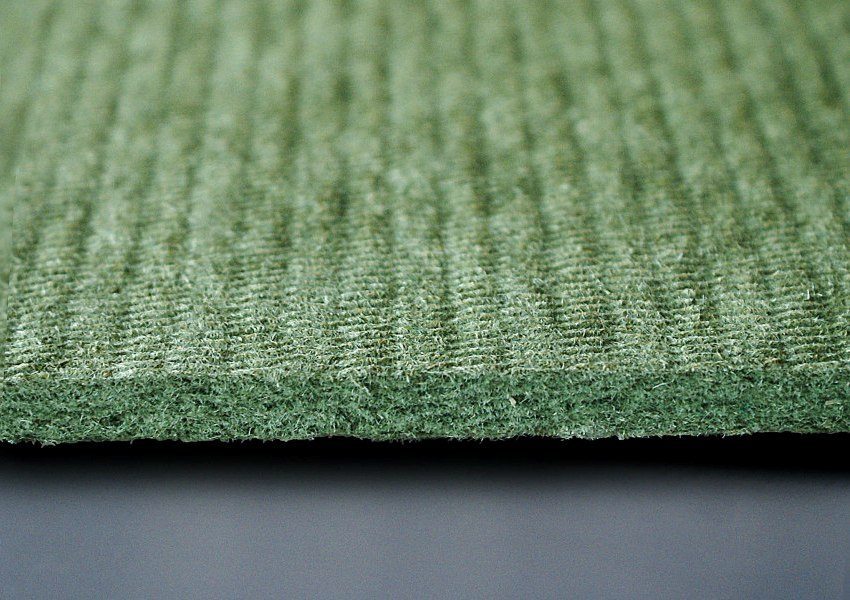Content
- Primer Composition
- Purpose and scope
- Technical specifications and application features
- Application Features
- Price
It is known that gypsum plaster, putty and paint are applied only to the prepared surface, in otherwise, the materials will almost certainly crumble after drying and upon further operation. Properly prepare walls, ceilings and other surfaces for subsequent decoration will help primer "Concrete contact." This universal tool improves the adhesion of materials and strengthens the work surface, increases its moisture resistance and resistance to any mechanical stress.

Primer Composition
It includes:
- quartz sand;
- styrene-acrylate dispersion, which is a binder component;
- cement;
- various fillers.

The water-dispersion primer "Concrete-contact" was created primarily to solve the problem of adhesion concrete and gypsum mixtures, which when applied to an unprepared surface simply slide on a smooth base.
Purpose and scope
Let us consider in more detail what the primer is for and where it is used:
- The primer composition plays the role of a link between the base and the applied finishing material. Even on a very smooth and slippery surface treated with this primer, anything will stick, since quartz filler creates a roughness resembling sandpaper, which provides high-quality clutch.
- Due to the penetration of substances into the structure of the base material, “Concrete-contact” makes its outer layer more durable.
- The composition is suitable for both porous absorbent surfaces and smooth, not able to absorb moisture.
- This primer is a solution to the problem of plastering monolithic concrete, on which gypsum plaster does not hold well due to poor moisture absorption.
Important information! Concrete Contact has one serious “contraindication”. It should never be used before plastering with cement mixes. The tensile strength of the film created by this primer is 0.4 MPa, and the adhesion of any cement mortar starts from 0.5 MPa. In addition, cement mixes shrink and the applied layer of plaster is slightly stretched. If the solution was applied directly to the concrete, no problems would have arisen, with “Concrete Contact” it would lag behind the wall.
USEFUL INFORMATION:Ceiling in the living room: design options

The name of the primer often gives the impression that it is used only for processing concrete slabs. In fact, "Concrete Contact" is universal, it is applied to almost any type of surface:
- on a brick;
- dense concrete;
- foam and aerated concrete;
- drywall gypsum sheetscement-bonded particleboards and tongue-and-groove plates;
- tile;
- bases leveled with cement or gypsum mixtures;
- surfaces coated with oil paint;
- tree;
- metal.
If necessary, "Concrete Contact" can be applied even to plastic and glass.
Compositions from different manufacturers have some differences, so it is advisable to read the characteristics of the primer and the scope of its application before purchasing. So, for example, “Betocontact” from Knauf, according to the manufacturer, is intended for processing smooth, weakly absorbing or non-moisture-absorbing substrates, which include concrete, plastered surfaces, polystyrene foam, gypsum-grooved gypsum slabs. It is applied under gypsum plaster, suitable only for interior use.
When buying, it is recommended to ask the seller for a certificate of compliance with established standards.
Technical specifications and application features
"Concrete contact" has the following properties:
- Drying speed. This primer dries very quickly. Depending on the surface area, the time of "readiness" is from 1 to 3 hours.
- Material consumption. The average value is 300 grams per 1m2. In fact, this indicator varies depending on the porosity of the surface and ranges from 150 to 500 grams per 1 m2.
- Moisture resistance. The coating has waterproofing properties due to the formation of a characteristic waterproof film.
- Life time. According to experts, the primer will not lose properties 70–80 years. However, this is only guaranteed if applied in compliance with the rules.

Features of handling the composition:
- The primer is applied at air temperature from +5 to +30 degrees Celsius. The humidity should not exceed 80%.
- Despite the rapid drying, the paint is applied only 12 hours after priming.
- Finishing material should be applied no later than one day, since dust reduces the adhesive properties.
- It is possible to dilute a primer with water.
- Packs of 3, 5, 6, 10, 14 and 20 kg are available for sale.
USEFUL INFORMATION:Using moisture-proof drywall in the bathroom
Concrete Contact is valued for not having an unpleasant odor. In addition, it is allowed to carry out processing indoors without the need for personal protective equipment.
Concrete contact does not have its color. But in most cases, pink dye is added to it at the factory so that poorly treated areas can be seen when coating the surface. On sale, it is already in a condition suitable for use, which eliminates the need for kneading, applied by brush or roller. Following the example of manufacturers of other primers, some companies have launched a product in spray cans that spray material onto walls or ceilings.
Manufacturers produce "Concrete Contact" with different grain sizes, on which the purpose of the primer depends. The composition with a fine filler is suitable for subsequent application of putty, paint, with a larger one - for plaster.
Application Features
Before applying "Concrete-contact", it is necessary to carry out preliminary surface treatment. To do this, you need to clean the wall or ceiling from dirt, wipe off the dust and scrape off the elements that will peel off.
After preparatory work, you can begin to apply the primer.
- First, a solution is prepared. It must be thoroughly mixed, since heavier particles (sand and cement) go down and they need to be balanced with the rest of the composition.
- When applying, use a brush or roller. The technical characteristics of the primer can be limited to just one layer. But if there is a need, for example, the wall is too uneven, you can apply the second.

The second layer of Concrete Contact is needed if the primer is completely absorbed, gaps are visible on the surface or the coating is easily removed by hand.
- While the material sets, you can begin preparations for further decoration.
USEFUL INFORMATION:DIY floor repair fast and inexpensive
Any the primer dries about 2-3 hours. In rare cases, time can be reduced to 60 minutes. To check the condition of the surface, a metal spatula can be drawn along it. If traces remain - the soil is not ready for further processing.
How much “Concrete Contact” is required depends on the type of surface.
- For porous substrates (concrete slabs, bricks), the soil consumption will be 300–500 g / m2.
- For surfaces with medium porosity (monolithic concrete, bulk floors), the flow rate will be 250–300 g / m2.
- For smooth substrates (reinforced concrete, tile, walls painted with oil paint) - 150–250 g / m2.

To reduce the consumption of Concrete-contact on porous substrates, it is possible to pre-impregnate the surface with a deep penetration primer.
Price
The cost of the primer depends on its quality and the reputation of the manufacturer.
- The cheapest primer can be found from 30 rubles per kg. So, “Concrete Contact” of the Rainbow brand costs 25–45 rubles. per kg
- If you consider a not too famous brand, you will have to pay about 60–90 rubles. per kg This price category includes primers of the brands "Prospectors", "Founded", Pufas, "Bolars".
- When you purchase the most expensive material, the cost can be 100-160 rubles. per kg For example, the average price for Betocontact from Knauf in Moscow is 125 rubles. for 1 kg. At the same time, high-quality soil of the famous Ceresit brand is cheaper - 70 rubles. for 1 kg.

You need to choose according to your financial capabilities and how many square meters you plan to process. When all the rooms of the apartment are to be finished, then you can use a primer of the middle price category. If water-repellent properties and durability are important, then it is worth paying attention to more expensive and high-quality products.
You can clearly see where and how "Concrete Contact" is applied by watching the video.


